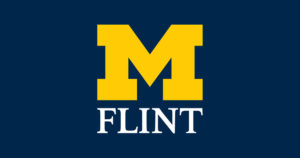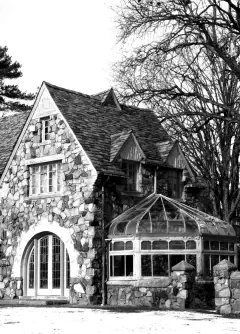By Paul Rozycki
“Academic politics makes me yearn for the simplicity of the Middle East.”
-Henry Kissinger
Could the University of Michigan-Flint go the way of Auto World?
Probably not. But there are more than a few who are worried that the Flint branch of the Ann Arbor campus could face the same fate as the downtown auto-based amusement center that was closed and demolished in the 1980s, after failing to live up to expectations.
Ironically, one of the UM-Flint’s newer structures, the William S. White Building, which houses the School of Nursing and College of Health Sciences, sits on the site of the old Auto World.
Financial and enrollment challenges
Last month, in a community forum Sept. 23, UM-Flint Chancellor Debasish Dutta said that the college was facing major enrollment and financial challenges. “This is serious,” he asserted. Mary Sue Coleman, the outgoing president of the Ann Arbor campus said, “The financial realities facing this campus are significant. I want to be direct: incremental progress is not enough, nor will it be sustainable going forward.”
The Flint campus has faced declining student numbers and low graduation rates, according to Dutta. Enrollment has declined by 30 % since 2014-15 and its six-year graduation rate is the lowest among the 15 public state universities. The ratio of faculty to students is significantly lower than other public universities in the state. He said the current situation is “not financially viable” and that the Flint campus would need to reevaluate its program and shift resources to those that are stronger financially. However, at an Oct. 20 Regents meeting in Flint, university’s admissions director highlighted an 8 percent increase in new-degree seeking students in the Fall 2022 semester.

UM-Flint Recreation Center. (Photo by Tom Travis)
Dutta said the college has hired the Huron Consulting Group to lead the process of carrying out the needed changes at the college, and that the planning stage would take place over the next month.
Several speakers at the October Regents meeting in Flint expressed concerns that the Huron group has a history of gutting the liberal arts and humanities. One of them urged the Regents to “fire Huron Consulting.” Dutta promised there will be many opportunities for the community to learn of the planned changes for the Flint campus. In response to concerns that the community wasn’t being heard, Dutta has said, “I want to emphasize that no decisions have been made. We are taking this process very seriously.”
He indicated that the community interests would be heard but also said, “Ultimately this is the University of Michigan and we will make our own decisions.”
At that Sept. 23 forum, faculty members, community members and students urged the Flint campus to become more involved with the downtown and the larger Flint community. Dutta and others expressed the desire to listen to the voice of the Flint community as they moved forward. Many expressed optimism that whatever transformation takes place will make the Flint campus stronger and better able to survive into the future, while others are not so sure.
The history of the UM and Flint
While Auto World had a brief connection with Flint, the University of Michigan has nearly a century of working with Flint and its educational institutions.
In the 1920s and early 1930s Flint Junior College (now Mott Community College) gave Flint residents an avenue to the Ann Arbor university by offering much of the work needed for the first two years of a UM degree. Many of the courses offered at the Junior College were parallel to those on the Ann Arbor campus and designed to allow students to transfer easily. In the Junior College’s earliest days, most students did transfer to the Ann Arbor university.
It was C.S. Mott who initiated the idea of bringing a full UM campus to Flint. In a meeting with then UM President Ruthven in 1946, Mott suggested the idea. Mott pledged to give $1 million to the project if the voters would pass a $7 million bond issue, which they did.
However, it would take some years before the new campus became a reality. The new campus was to be part of the newly created Cultural Center being created with major donations from many Flint leaders. While Mott and other Flint donors were strongly supportive of creating the new branch campus, Ann Arbor was less so, but in the end agreed to the creation of the UM-Flint. Many thought the UM-Flint branch would be created by expanding the Junior College, but conflicts between wills and trusts of two major benefactors—C.S. Mott and William Ballenger—caused the colleges to remain separate institutions.
For a number of years, however, they shared the Court Street campus as the UM-Flint began in 1956 with 118 full-time and 49 part-time students. They remained on the campus, sharing a library and a student newspaper, as they pursued a 2+2 program with the Junior College, until they began moving to their current downtown location in the late 1970s. From that location, the University of Michigan – Flint grew to the major branch of the University of Michigan it is today.

The UM-Flint University Pavilion on Saginaw St. downtown Flint. (Photo by Tom Travis)
The implications of the changes
At this point we don’t know what will be the future path for the University of Michigan-Flint. There will be weeks and months of meetings and forums before that future is clear. But at this time it seems there are two major paths.
On one hand, if the University were to end its connection with UM-Flint, the impact would be enormous and devastating to the faculty and staff. It would be a huge blow to the development of the downtown — and the whole City of Flint — far surpassing the closing of Auto World. Given the commitment from the Mott Foundation and the whole Flint community, that seems unlikely, but not impossible. After all, Baker College, which began in Flint, chose to leave, in spite of having a large physical presence.

(Graphic source: www.umflint.edu)
On the other hand, if UM-Flint were to shift away from the traditional liberal arts and humanities programs that have long been a part of the university experience – in particular, the University of Michigan – Flint experience — and move to a technical STEM-based curriculum, it would also have a major impact. Obviously within the college it would mean a loss for those in the humanities and liberal arts programs and a gain for those in the occupational or STEM areas.
A number of students and faculty in the liberal arts spoke at the recent Regents meeting, urging the UM-Flint to keep to its tradition in the humanities and liberal arts. Beyond UM – Flint, a move to the STEM based curriculum would have a significant impact on both Kettering University and Mott Community College. Would all three schools be competing for the same students? And what would that mean for overall college enrollment in the city?
How to have your voice heard
At this point there is a lot we don’t know. There have been several forums with the Regents of the UM, discussing some of the options. Chancellor Dutta said he has already held at least 21 meetings with interested community and college members. There have been a few news stories suggesting what path the University might take, from making a few modest changes to shutting down entirely and all points in between.
The scheduled public meetings of the Board of Regents and UM-Flint leaders will be announced in the future. Many of those will allow members of the public to express their views on the future of the UM-Flint. The University has a website, https://www.umflint.edu/strategic-transformation/, to keep the public informed of the decisions being considered.
East Village Magazine will stay with the story both in print and on-line to keep you updated on this important story.

Paul Rozycki
EVM political writer and commentator Paul Rozycki can be reached at paul.rozycki@mcc.edu.


You must be logged in to post a comment.